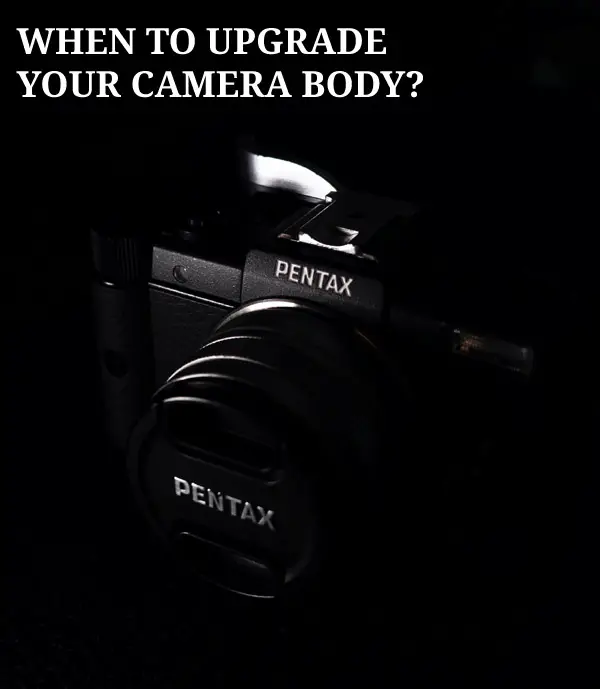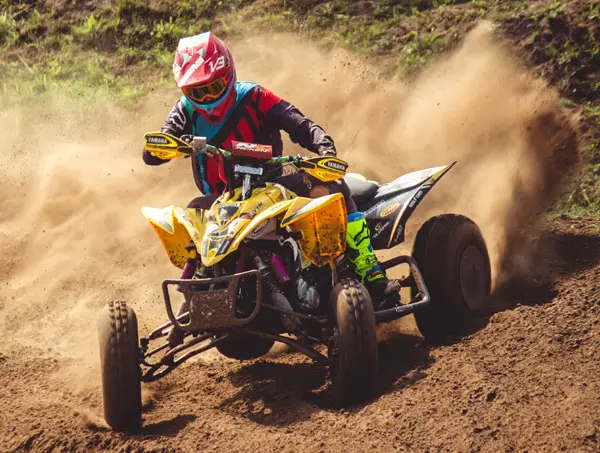When to upgrade your camera body is a question that often confuses many photographers, especially amateur ones.
The decision can be daunting, especially considering the investment involved.

Your current gear might seem sufficient, but could it be holding you back from capturing even better images?
Deciding to upgrade your camera body is not only about staying up-to-date, but also ensuring you have the best equipment for honing your photographic skills.
Figuring Out the Right Time to Upgrade Your Camera Body
Photographers often grapple with this conundrum – when should they upgrade their camera body? The past five years have seen a surge in camera technology, resulting in models that are both robust and powerful. But like all good things, even these machines have an expiration date.
The ticking clock of shutter actuations reaching its lifespan limit is one telltale sign that your current gear might need a revamp. Let’s jump into some more signs and considerations for an upgrade.
Picking Up on Signs of Wear and Tear
A declining image quality despite multiple lens changes or settings adjustments can be indicative of your current camera’s aging process. If you’re noticing persistent issues such as lackluster sharpness or inaccurate colors, it could be time for a change.
Sometimes, upgrading isn’t about worn-out equipment but rather about outgrowing what once fit snugly into your camera bag. As photographers evolve, so do their needs; perhaps low-light performance isn’t meeting expectations anymore or faster autofocus has become indispensable for capturing those fleeting moments.
Gauging When to Switch Gears
If you’ve decided based on such reasons to consider an upgrade – fantastic. The next question would be whether to opt for newer models from the same brand or switch brands altogether depending upon specific features offered by different camera models.
Evaluating Potential Upgrades Against Current Gear Performance
An essential part of this decision-making process involves assessing if potential upgrades offer substantial improvements over what’s already working well for you. It’s crucial not just to have good reasons for wanting something new but also to ensure that any possible upgrades truly enhance your photography experience compared to existing gear capabilities.
Mirrorless Camera Body Upgrades
Just as technology continually evolves, so does the world of photography. In particular, mirrorless cameras have carved a niche for themselves with their compact design and stellar performance. Upgrading tech gadgets is inevitable; mirrorless cameras are no exception.
“Upgrading your camera body can feel like stepping into a whole new realm of possibilities.”
A New Dawn: Enhanced Low-Light Performance and High ISO Capabilities
Photographers often opt to upgrade their mirrorless camera bodies in pursuit of better low-light performance. The latest models typically boast superior sensors that excel at capturing light even in dimly lit conditions – without relying on artificial lighting or flash.

Beyond this, upgraded versions generally offer more impressive high ISO capabilities. This essentially makes your camera sensor more sensitive to light – an indispensable feature when shooting clear photos under less than ideal natural lighting conditions.
Capturing Motion: Faster Burst Rate for Action Photography
If you’re an action photographer, upgrading your camera body could be particularly beneficial. Why? Because newer models usually provide faster burst rates – meaning they can take multiple consecutive pictures per second while keeping fast-moving subjects in sharp focus.
In addition to this perk, most upgraded models come equipped with advanced autofocus systems that track moving objects with remarkable speed and accuracy – ensuring those critical moments are never missed during any event or sports game.
Lifespan Matters: Considering Shutter Actuations
| Mechanical Shutter Lifespan Range: |
|---|
| Ranging from 50k-500k shutter actuations before requiring replacement/repair. |
This range might seem broad, but consider how many shots professional photographers fire off daily – it’s not unheard of for shutters needing replacement within just a few years depending upon model and usage pattern, thus making upgrades necessary at times.
You should also consider checking out Camera Shutter Count. This nifty tool gives you insights into how much life is left in your current camera body by revealing its shutter actuations.
Unraveling the Mystery of Camera Body Upgrades
The decision to upgrade your camera body isn’t one you should take lightly. It’s a journey filled with technical jargon, budget considerations, and personal preferences.
Let’s make the process of upgrading your camera body seem less overwhelming by breaking it down into smaller steps.
Identify Your Photography Needs
To start off, ask yourself why you need an upgrade. Are your low-light shots lacking detail? Or maybe fast-moving subjects are leaving you in their dust?
If high ISO performance is what you’re after for those challenging light conditions, then upgrading could be the right move for you. Remember: better low-light performance equals more detailed images even when lighting isn’t ideal.
A faster burst rate is another perk of newer models which might interest sports or wildlife photographers who require quick shutter speeds to capture fleeting moments perfectly.
Consider Your Budget
An essential step before diving headfirst into an upgrade is understanding depreciation – yes, we’re talking about finances here.
- Your new shiny gadget will depreciate over time – sometimes significantly within its first year on the market.
- You don’t want to be stuck with a product that has quickly lost its value after investing in it.
- Weigh up whether investing in brand-new tech now will give enough returns later based on how often and where you use your gear.
Make a Smart Decision
In conclusion, it’s not always about having the latest technology; sometimes sticking with what works best for your style can yield better results. After all, photography isn’t just about fancy gadgets—it’s also about skill, perspective, and creativity.
This journey may seem complicated, but by taking these factors into account, you’ll make informed decisions regarding equipment upgrades. Remember: this choice should ultimately serve your creative vision—not hinder it.
Avoiding Impulsive Upgrades Based on Marketing Hype
It’s crucial not to let marketing tactics cloud your judgment when an opportunity for an upgrade arises. Ask yourself: does this shiny new model offer significant improvements that align with my specific photographic needs?
If so, then go ahead—splurge. If not, perhaps hold off until something more suitable comes along.
Evaluating Your Budget vs Desired Features
The cost-benefit analysis is key here. Look beyond just the price tag—consider whether investing in quality lenses might be more beneficial than upgrading the entire camera body itself.
- Analyze prices across different brands and models offering similar features—you may find comparable capabilities at lower costs.
- Determine if newer features align with what you need from your equipment—are they worth paying extra for?
The Right Time to Upgrade Your Camera Body
For many photographers, the initial thought when looking to enhance their photography skills leans towards upgrading their camera body. But, a more effective route often lies in investing in quality lenses.
Your camera body is the heart of your photography gear, and upgrading it can have a significant impact on your images. Here are some key signs that it may be time to consider upgrading your camera body:
Improved Image Quality
Newer camera bodies often come with advanced sensors and image processors, resulting in improved image quality. If you’re not getting the desired sharpness, noise levels, or performance in low-light from your current camera, investing in a newer model may help to improve those results.
Enhanced Performance
Upgrading your camera body can also provide you with enhanced performance features. This can include faster autofocus systems, higher burst rates for capturing action shots, improved low-light performance, and better overall handling and ergonomics. If you frequently shoot in challenging conditions or need faster and more reliable performance, a camera body upgrade can be beneficial.

Expanded Creative Possibilities
Newer camera bodies often come with additional features and capabilities that can expand your creative possibilities. This can include advanced shooting modes, built-in Wi-Fi or Bluetooth for easy image transfer, touchscreen interfaces for intuitive control, and improved video recording capabilities. If you feel limited by the features of your current camera body, upgrading to a newer model can open up new avenues for creativity.
Compatibility with New Technology
As technology advances, new camera bodies often come with compatibility for the latest accessories and software. This can include compatibility with newer lenses, flashes, and other accessories, as well as improved compatibility with editing software and post-processing workflows. If your camera isn’t able to keep up with the most recent technological advancements, then upgrading could be a wise decision in order to remain current and reap the benefits of cutting-edge progress within this field.
What About Lens Upgrades?
Navigating the realm of lens enhancements may appear daunting, but it’s actually quite straightforward once you know what to pay attention to. Here are some key factors to consider while upgrading lenses for your mirrorless camera.
Grasp Focal Length Fundamentals
The first step is understanding focal length and its impact on your photography. The right choice here will drastically change how much of the scene gets captured in your shots.
If landscapes call out to you, shorter focal lengths might be up your alley as they offer wider angles. For portrait enthusiasts, though, longer focal lengths could provide more flattering perspectives. The trick is experimenting with different ones before deciding on an upgrade – that way, you’re making informed choices based on personal experience instead of guesswork.
Understand Your Camera Specifics
Mirrorless cameras come with their own set of unique characteristics such as specific mount systems and sensor sizes which dictate compatible lenses. So when contemplating an upgrade, compatibility should be high up on your checklist.
Besides this technical aspect, don’t forget practical considerations like weight and size – these affect comfort during long shooting sessions, so make sure any potential new lens won’t turn those enjoyable photo walks into workouts.
Budget Wisely for Your Upgrade
Lens upgrades aren’t one-size-fits-all – especially not where budgets are concerned. They range from affordable options all the way through premium models that run into thousands of dollars.
- Determine whether investing in top-tier glass now would save money down the line by reducing future upgrades or if sticking within a reasonable price range makes better sense even if it means potentially needing further enhancements later.
- A critical point worth remembering is quality glass tends to retain value over time compared to camera bodies – something definitely worth factoring into budgeting decisions.
With these points considered carefully, there’s no doubt navigating lens upgrades becomes far less daunting.
Evaluating Training and Experience Over Gear Upgrade
Quality images aren’t just about the gear. They’re about proper technique, understanding your equipment, and leveraging that knowledge to capture a perfect moment.
The misconception is that upgrading your camera body automatically equals better photos. But it’s not always true – experience and training often play a larger role in image quality than the gear itself.
Why Training Matters More Than Upgrading
Better photography skills don’t come from new equipment but through learning elements of proper technique such as exposure, composition, lighting, and post-processing. This knowledge can transform an average photo into something truly breathtaking.
Surely a newer camera might offer higher resolution or faster autofocus, but without knowing how to optimally use these features, they may not significantly improve your work.
The Importance of Experience
Gaining experience through consistent practice helps you understand various shooting conditions and adapt accordingly – this is something no amount of upgraded gear can replace for you.
In fact, many professional photographers prefer using older models because they know their performance under different scenarios, which gives them greater control over their shots compared to using unfamiliar latest technology. Learn more here.
FAQs
When to Upgrade Your Camera Body
If you’re unsure when to upgrade your camera body, there are a few key signs to look out for. First, if your current equipment is limiting your creativity or not performing optimally, it might be time for an upgrade. Additionally, if your camera is worn out and not functioning as it should, it’s worth considering a new body.
How Often Should You Replace a Camera Body?
The lifespan of a camera body can vary, but with proper care and maintenance, most modern cameras can last for several years before needing to be replaced. It’s important to regularly clean and service your camera to ensure it stays in good working condition.
When to Upgrade to a Full-Frame Camera
If you’re looking to take your photography to the next level, upgrading to a full-frame camera may be a good option. Full-frame models offer improved image quality, better low-light performance, and a wider field of view. This upgrade is particularly beneficial for professional photographers or those who are serious about their craft.
Does the Camera Body Affect Image Quality?
Definitely. Not only do lenses matter, but the camera body’s crucial too. It’s got a sensor that decides resolution and light sensitivity, directly influencing your image quality.
Conclusion
Upgrading your camera body is a decision that should not be taken lightly. It is important to know when and why you need to make this upgrade. Your old gear may be showing signs of wear and tear, or it may simply be unable to keep up with the demands of your evolving photography skills.
When considering mirrorless cameras, there are specific factors to consider, such as high ISO performance and faster burst rate.
Sometimes, what you really need is not a new camera body but better lenses. Quality lenses can make a significant difference in image quality for both mirrorless and DSLR cameras.
However, it is important to remember that beyond equipment upgrades, your skill as a photographer is more important than any piece of gear in your bag. Training yourself to use proper techniques will result in stunning images regardless of the camera model you are using. Click the following link to learn whether you should buy a new entry level camera or used high end one.








